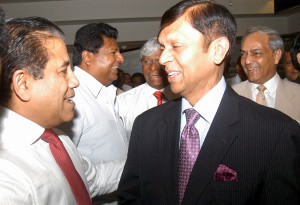‘We didn’t skid when taking the bend’ : Cabraal
View(s):Central Bank on 2012 economic performance
By Duruthu Edirimuni Chandrasekera
Tough policy decisions implemented at the beginning of last year helped the Sri Lankan economy arrest the global and domestic challenges, thereby avoiding skidding in the driveway, the Central Bank (CB) said on Wednesday.

The Central Bank Governor with guests at the event. Pic by Nilan Maligaspe
“Excessive credit demand and high imports, drought conditions that affected agriculture and hydro power generation and rains in the last quarter that disrupted food supplies were the local challenges that we faced. There were a host of global challenges such as persistently high petroleum prices, the US fiscal cliff, etc, but with the tough policy decisions taken early last year augured well for the economy,” CB Governor Nivard Cabraal told eminent dignitaries when he unveiled CB’s ‘Road Map 2013 – Monetary and Financial Sector Policies for 2013 and Beyond’. He said these policies by CB assisted the Sri Lankan economy in ‘taking the bend’ without skidding.
He said that amongst these measures, increase in policy interest rates and placing an 18 per cent ceiling on credit expansions by banks and an additional 5 per cent for foreign funds to tighten the monetary policy were prominent. “We allowed for greater flexibility in exchange rate while curbing speculative behaviour in the forex market. We imposed higher tariffs and excise duties on selected imports to tighten the fiscal policy,” Mr. Cabraal explained. The credit ceiling on Sri Lankan banks introduced last year to curb expanding credit has also been lifted and no more exists and it is expected that significant growth in credit will happen this year, he added.
He noted that as expected imports declined by 4.5 per cent during the first 11 months reflecting declines in both consumer and intermediate goods. Imports as a percentage of GDP were 31.5 per cent while exports were at 16.5 per cent in 2012.
The cumulative deficit in the trade account declined by 2.1 per cent to US$ 8,583 million during the first eleven months of 2012 from the corresponding period of 2011, according to the CB. Deceleration in the growth in the trade balance was driven by declining expenditure on consumer and non-oil intermediate goods imports, Mr. Cabraal added. The trade deficit, he said is expected to contract to 15.1 per cent of GDP in 2012, from 16.4 per cent in 2011.
Mr. Cabraal said that as a result of the contraction of the trade deficit and the increase in other earnings, the current account deficit reduced substantially in 2012. Other inflows to the current account were tourism and remittances, he said, noting that tourism is on an accelerator while workers’ remittances continued to bring in substantial foreign exchange. “Workers’ remittances are estimated to be around $6 billion in 2012, up by 16.8 per cent from $5.1 billion in 2011.” Migrant worker remittances in 2012 amounted to 10 per cent of GDP, according to the CB. Trade in services improved with BPO and KPO sectors gathering momentum and accordingly, the current account deficit are expected to reduce to $3.3 billion or 5.5 per cent of GDP in 2012, down from 7.8 per cent in 2011. Foreign exchange inflows on account of emerging services such as export of software and Information Technology Enabled Services (ITES), helped to support the current account substantially, Mr Cabraal said.
The Balance of Payments improved from a deficit of $1,061 million in 2011, to a surplus of over US$ 100 million in 2012. “It is expected to strengthen further in 2013 and beyond, with the gradual recovery of trading, services and investment partners across the globe.” However, in spite of significant price revisions, credit to public corporations increased in 2012, Mr. Cabraal said, noting that it increased “by around Rs. 63 billion.” The bulk of the increase was due to credit extended to the Ceylon Electricity Board (CEB) and Ceylon Petroleum Corporation (CPC), as a result of CEB’s reliance on thermal power generation due to erratic weather patterns and continued drought, he said, noting that CEB’s increased cost of generation and the re-imposition of the Fuel Adjustment Charge (FAC) did not offer sufficient relief to cover costs.
Domestic petroleum prices were revised substantially in February 2012 and again in December 2012. “These measures have served to reduce the losses of CPC, but still, significant losses are incurred,” Mr. Cabraal pointed out. He also noted that the CPC selling fuel at a loss to the transportation sector, and supplying fuel to CEB for electricity generation at well below cost added the increase in credit. “Urgent steps need to be taken to ensure that these two institutions reach at least break-even level by end 2013, in order to ensure their viability and to eliminate any imbalances being created in the banking sector.”
He said that last year’s debt to GDP ratio was 81 per cent against 78.8 per cent in 2011. Inflation continued to remain at single digit level for the 47th consecutive month in December 2012, Mr. Cabraal said, noting that it decreased to 9.2 per cent in December 2012 on a year-on-year (YoY) basis from 9.5 per cent in the previous month. However, the inflation rate on an annual average basis increased to 7.6 per cent in December 2012 from 7.2 per cent in November 2012.
The country’s economy grew by 6.5 per cent in 2012, down from a projected 8 per cent. He said that the country is well on track to achieving its target of doubling the per capita income to US$ 4,000 by 2016. “As such, the Central Bank is now focusing on preparing for the post $4,000 era by ensuring that Sri Lanka progresses along a steady growth path by carefully planning a second wave of growth to avoid the ‘middle-income trap.”
Follow @timesonlinelk
comments powered by Disqus




















